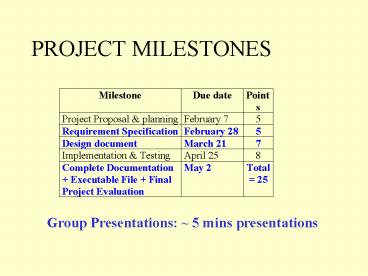PROJECT MILESTONES PowerPoint PPT Presentation
Title: PROJECT MILESTONES
1
PROJECT MILESTONES
Group Presentations 5 mins presentations
2
Introduction to Software Engineering
3
What is Software Engineering?
- Software?
- Websters Dictionary the entire set of
programs, procedures, and related documents
associated with a system - Engineering?
- Websters Dictionary The practical applications
of scientific and mathematical principles
4
What is Software Engineering?
- SE is a discipline whose aim is the production of
fault-free software, on time, within budget, that
satisfies the users needs.
5
Scope of Software Engineering
- Scope of SE is extremely broad
- Historical aspects
- Economic aspects
- Maintenance aspects
- Specification and Design aspects
- Team Programming aspects
6
Historical Aspects
- The Term Software Engineering first used at the
1968 NATO conference - Aim to solve the Software Crisis
- Software Crisis low quality, over budget, and
late. - Software Engineering Versus other Engineering
fields.
7
Historical Aspects cont.
- building bridges vs operating systems?
- Bridge collapse vs OS crash
- perfect engineering vs fault tolerance
- Complexity
- bridges are analog. Described by continuous
mathematics. - software systems are discrete. The total number
of all possible states can be vast. - Some not considered by developer
8
Historical Aspects cont.
- Maintenance
- software maintenance is much more complex
- Corrective maintenance
- Enhancement maintenance
- SE is fairly new (25 years)
9
Economic Aspects
- Software Engineering Versus Computer Science
- Computer scientist investigate all solution to a
problem - Software engineer interested only in those
solutions that make sound economic sense. - short term effects Versus long term effects
- Phases of the Software Life Cycle
10
Maintenance Aspects
- Phases of Life Cycle
- Requirements
- Specifications
- Design
- Implementation
- Integration
- Maintenance
- Retirement
- Cost of all phases must be taken into account
11
Maintenance Aspects Cont.
- Maintenance is a very costly phase
- Fig. 1.2 Maintenance constitutes 67 of total
cost - Good software is maintained--Bad software is
discarded - Different types of maintenance
- corrective maintenance 20
- enhancement
- adaptive maintenance 20
- perfective maintenance 60
12
Specification and Design Phase
- Errors exist
- Better to fix errors during earlier phases
- cost increases very sharply (see Fig 1.4 1.5)
- 60 to 70 of faults are specification and design
faults - need new techniques to avoid errors during Spec.
and Design phases.
13
Team Programming Aspects
- Hardware cheap -- can build products too large to
be built by one person in available time. - Team projects
- Interface problems
- Communication Meetings/conferencing
- Team Organization
- Suppose a product takes 1 programmer 1 year
- Generally, itd take a group of 4 programmers
more than 3 months
14
Structured Vs. Object-Oriented Paradigms
- Structured paradigm (1975-1985)
- structured systems analysis, design, programming,
testing - had great success initially
- Started to fail with larger products (gt50,000
LOC). Did not SCALE UP. - Reason either action oriented or data oriented
but not both.
15
Object-Oriented Paradigm
- Both data and actions are of equal importance
- Object Software component that incorporates both
data and the actions performed on that data. - Example
- Bank account
- data account balance
- actions deposit, withdraw, determine
balance
16
OO Paradigm Cont.
- Object-Oriented paradigm(see Fig. 1.6)
- Encapsulation actions done on an object are
implemented within that object - gt conceptual independence
- gt independence of effects
- Information hiding implementation details are
hidden from outside the object - gt reduce the level of complexity
- gt Maintenance less costly
- gt Object reuse
17
Transition from Analysis to Design
- Structured paradigm
- Analysis
- determine what product is to do
- Design
- architectural design project is broken into
modules - Detailed design each module is designed (data
structures and algorithm for each module) - Transition is too sharp
18
Transition from Analysis to Design
- OO paradigm
- Object-Oriented Analysis
- determine what the product is to do
- extract the objects
- Object-Oriented design
- detailed design of the objects
- Objects enter the Life Cycle at early stage

